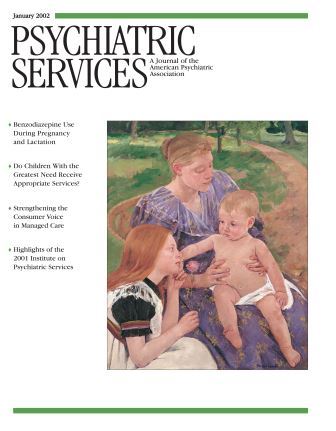Prevalence and Severity of Mental Health-Related Disability and Relationship to Diagnosis
Abstract
OBJECTIVE: Psychiatric disability has been defined largely from measures that focus on serious mental illness. This practice may have led to substantial underestimation of the total impact of mental disorders on community health. In this study a generic measure of mental health-related disability was used to examine disabilities attributable to various common mental disorders. METHODS: Data were drawn from the Australian National Survey of Mental Health and Wellbeing, a household survey of 10,641 adults that assessed participants for 14 DSM-IV disorders with use of the Composite International Diagnostic Interview. Screening instruments were used to identify likely cases of ICD-10 personality disorder, neurasthenia (an undifferentiated somatoform disorder), and psychosis. Mental health disability was assessed with the Medical Outcomes Study 12-item Short Form (SF-12) mental health summary scale, which was administered to all participants. RESULTS: Disability was significantly greater among participants with a current psychiatric diagnosis, and disability varied by type of disorder. Diagnosis remained a strong predictor of disability after sociodemographic factors and physical illness were controlled for. Disorders found to be independently associated with disability were depression, panic disorder, agoraphobia, social phobia, generalized anxiety disorder, alcohol dependence, and drug dependence. CONCLUSIONS: Substantial proportions of persons with mental disorders that are not usually classified as major mental disorders reported moderate and severe disability. A generic measure of mental health-related disability was able to detect variations in disability among persons with different diagnoses. Although such a measure is not as sensitive as a disorder-specific measure developed for use in psychiatric populations, it can facilitate comparison of disability across common mental disorders.
Disability and quality of life are increasingly recognized as crucial factors in assessing mental health (1). Although psychiatry has a long history of measuring functional impairment, these measurements have often been made with instruments designed specifically for use with psychiatric populations (2), particularly persons with serious mental illness (3,4,5). Limiting the concept of psychiatric disability to the more severe—and often less common—disorders may substantially underestimate the total impact of mental disorders on the health of the community. Furthermore, as funding for mental health services continues to be threatened (6), measuring health outcomes in ways that are not comparable across various mental disorders or with other areas of health may mean that mental health is sidelined in the competition for resources.
An alternative to psychiatry-specific measures are the so-called generic measures of health status (1,7), which purportedly can be used across all areas of health care. Studies that have used generic measures have raised awareness in the general medical community of the importance of mental disorders as a cause of ill health (8,9,10,11,12,13,14,15). But can generic measures inform comparisons of disability associated with various mental disorders? The few available studies suggest that the proportion of individuals who are disabled (16) and the severity of disability (17) vary according to the type of mental disorder and that after comorbidity and sociodemographic factors are controlled for, not all mental disorders are uniquely associated with disability (8,13,14,18). None of these studies investigated disability among persons with a current DSM-IV diagnosis in a community sample. Furthermore, most studies covered a limited range of disorders and, in the case of some disorders, used small samples.
In this study we examined the Medical Outcomes Study 12-item Short Form (SF-12) (19) as a generic measure of disability and well-being across all the major DSM-IV mental disorders. The SF-12 provides a mental health summary scale and thus was the most appropriate to our aim of investigating the comparative uses of generic measures in mental health. Specifically, we compared the prevalence and severity of disability associated with a large number of mental disorders in a cross-sectional community sample. We also examined the correlates and the importance of a diagnosis of a mental disorder in self-reported mental health disability and investigated which mental disorders were independently associated with disability after sociodemographic factors and comorbidity were controlled for.
Methods
Sample
The Australian National Survey of Mental Health and Wellbeing (20) was a nationally representative household survey of mental disorders among adults. A stratified multistage and multiarea survey of private dwellings included individuals who were 18 years of age or older and who normally lived in private households. Persons in hospitals, nursing homes, jails, and other public facilities and those who lived in remote and sparsely settled parts of the country were excluded. A total of 13,624 dwellings were initially selected, and one adult in each dwelling was randomly selected as a potential respondent. A total of 10,641 people participated in the survey, for a response rate of 78 percent.
Participants were interviewed in their homes between May and August 1997 by experienced survey administrators from the Australian Bureau of Statistics who were trained to reliably administer the diagnostic interview. The interview was fully computerized. The interviewers asked the questions and entered the respondents' answers directly into the computer program. The participants received comprehensive written and spoken information about the purpose and nature of the interview. The study was conducted in compliance with the Federal Census Act of Australia.
The sample was weighted to match the age and sex distribution of the Australian population: the participants' mean age was 45 years, and 51 percent were women. Sixty-five percent of the participants were married, 63 percent were currently employed, and 48 percent had a college or university education. Most resided in a metropolitan area (73 percent) and were born in Australia (75 percent). Thus the sample was representative of the Australian adult population.
Diagnostic assessment
The survey incorporated the computerized version of the Composite International Diagnostic Interview, version 2.1, a fully structured diagnostic interview with good reliability and validity (21). Participants were asked questions about symptoms pertaining to DSM-IV diagnoses of affective, anxiety, or substance use disorders during the previous 12 months. These symptom responses are assessed against the diagnostic criteria to generate diagnoses (21). Drug use disorders included abuse of and dependence on cannabis, sedatives, amphetamines, or opioids. However, the rates of use for individual drugs were too few for their numbers to be presented separately. Drug and alcohol abuse entail abuse without dependence.
We were concerned only with current diagnoses—those for which the participants had experienced symptoms in the previous four weeks—because disability was assessed over a four-week period. DSM-IV exclusion rules were not applied. Screening instruments were used to identify likely cases of the nine ICD-10 personality disorders (22), psychosis (23), and neurasthenia (24), which is included under DSM-IV undifferentiated somatoform disorders (25). Physical disorders were assessed with a self-report yes-or-no checklist for 12 common chronic conditions: asthma, chronic bronchitis, anemia, high blood pressure, heart problems, arthritis, kidney disease, diabetes, cancer, stomach or duodenal ulcer, chronic gallbladder or liver problems, and hernia or rupture (26).
Measures of disability
Participants completed three measures that assessed disability during the previous month: the SF-12, the Brief Disability Questionnaire (BDQ) (10), and the number of disability days. The 12 items on the SF-12 are summarized in two weighted summary scales—mental health and physical health; lower scores indicate more severe disability. The items related to mental health cover limitations to usual activities and emotional state. We report only the results of the mental health summary scale, which has adequate test-retest reliability (r=.76) and sensitivity to recovery from depression (19). The SF-12's parent measure, the SF-36, has been shown to have good psychometric properties and has been used successfully in outpatient psychiatric settings (6). The BDQ's five-item role functioning subscale (27) was used in this study for comparisons with mental health disability. The number of disability days is a summary measure of the total number of days in the previous four weeks in which activities could not be performed or had to be scaled down because of ill health (8).
Analysis
All proportions and mean scores represent weighted values to account for the probability of an individual household member's being selected and to comply with the age and sex distribution of the Australian adult population. Although familiar statistical procedures—linear regression and logistic regression—were used to analyze the data, the complex sampling strategy required the use of specialized software to perform the statistical analysis and to estimate standard errors. This software takes into account the variability within and across the geographical sampling units from which the survey respondents were randomly selected. Without such software, variance in statistical estimates can be underestimated, which could result in statistically significant findings that would not otherwise have been significant. Variances in these estimates—proportions, odds ratios, and nonstandardized regression coefficients—were thus estimated with use of the SUDAAN software package for survey analysis, version 7.5.3 (28).
The prevalence of disability was obtained by categorizing individual scores on the SF-12 mental health summary scale into four levels of disability: no disability, represented by a score of 50 or higher; mild disability, 40 to 49; moderate disability, 30 to 39; and severe disability, a score below 30. This classification was considered useful because the SF-12 score is not readily interpretable.
These four levels of disability were adapted by collapsing a nine-level categorization used by Ware and colleagues (29) to help interpret the mental health summary scale—9 to 29, then seven five-level increments (30 to 34, 35 to 39, and so forth), and then 65 to 74. The validity of the four levels of disability was investigated by comparing them with five disability-related variables: presence of any current mental disorder as opposed to none, presence of two or more mental disorders as opposed to one or none, consultation with a mental health specialist—a psychiatrist, a psychologist, a social worker, a counselor, a nurse, or a mental health team—as opposed to no consultation, significant difference in mean BDQ score as opposed to no significant difference, and any disability days as opposed to no disability days.
We calculated unadjusted odds ratios by using logistic regression for the dichotomous variables to assess the simple relationship between disability levels and the related variables; significance was assessed with the Wald chi square statistic. The significance of differences in BDQ scores was determined with planned contrasts. These analyses were used to determine whether an increasing level of disability was mirrored by increases in the five disability-related variables. Significance was controlled at .05 by dividing by the number of disability variable comparisons (.05 divided by 5=.01).
Disability related to each disorder was first examined through mean scores and bivariate regression coefficients from bivariate linear regressions. These coefficients predict differences in SF-12 scores between persons who have a particular disorder and those who do not have that disorder. We then conducted a hierarchical linear regression to examine the correlates of disability in the entire community sample and the strength of the association between disability and diagnosis when other factors were controlled for. This analysis also provides the predicted difference in SF-12 scores for each diagnosis but controls for the influence of sociodemographic variables and co-occurring mental and chronic physical conditions.
The variables were entered in three steps; the third step determined the importance of the DSM-IV diagnosis in predicting disability when the previously entered variables were controlled for. The statistical comparisons were with persons who did not have a particular disorder; for the multivariate hierarchical regression, significance was set at .05 or less.
Results
Prevalence and severity
The distribution of disability level by current mental disorder is summarized in Table 1. Of the participants who did not meet the criteria for one of the mental disorders included in the survey, only 7 percent had moderate or severe disability; however, 43 percent of participants with any current disorder had moderate or severe disability.
The level of disability varied substantially by diagnosis. Disability was particularly prominent among participants who had an affective disorder, panic disorder, posttraumatic stress disorder, or generalized anxiety disorder. For all types of disorders there were some participants without disability; the lowest proportion of persons without disability was for those who had affective disorders—6 percent; the highest was for those who had substance use disorders—47 percent.
Table 2 shows the relationship between level of disability and the five disability-related variables—presence of any current mental disorder, presence of two or more disorders, consultation with a mental health specialist, number of disability days, and mean BDQ score. The strength of the associations were greater at more severe disability levels, which suggests that the categories represent distinct levels of severity. Participants who scored below 30 on the SF-12, indicating severe disability, were highly likely to have one or more mental disorders, independently of a specific diagnosis, and to have consulted with a mental health professional. Participants with moderate disability were five times as likely and participants with severe disability were almost nine times as likely as those without a disability to report any disability days; for these participants, BDQ scores indicated more severe disability.
Disability by diagnosis
In Table 3 the mean SF-12 mental health summary scores are listed, along with the predicted difference in disability between participants who had a diagnosis of a particular mental disorder and those who did not. Persons with no current psychiatric diagnosis had a mean score in the "no disability" range. Linear regression analyses showed that participants with all DSM-IV disorders except alcohol abuse had significantly higher disability scores. In addition, participants who had any of the other disorders identified by the various screening instruments—personality disorder, somatoform disorder, and psychosis—were significantly more likely to report disability.
Correlates of disability
The correlates of disability, the importance of diagnosis in predicting disability, and the unique association of individual disorders with disability were investigated with use of a hierarchical linear regression model of the predictors of SF-12 mental health summary scores in the entire sample, as shown in Table 4.
Sociodemographic factors and co-occurring physical conditions were significantly associated with more severe disability. However, the strongest predictor by far was the presence of any mental disorder, which accounted for 18.8 percent of the variance after sociodemographic factors and physical conditions were controlled for. Mental disorders that had a strong independent relationship with disability included mild, moderate, and severe depression and generalized anxiety disorder. Disorders for which a moderate but independent relationship with disability was observed included panic disorder, agoraphobia, and alcohol dependence. A smaller—but still significant—unique association was found for social phobia and drug dependence. Dysthymia, obsessive-compulsive disorder, posttraumatic stress disorder, and alcohol and drug abuse were not independent predictors of disability.
Discussion
The generic SF-12 measure demonstrated variation in the proportions of people who reported mild, moderate, or severe disability. All mental disorders except alcohol abuse were significantly associated with some disability, although not all associations were significant after comorbid conditions—both physical and mental—were taken into account. We have extended the work of another population-based study (30) that showed a relationship between disability and depression and generalized anxiety disorder that was independent of comorbidity and sociodemographic factors by showing that this relationship exists for other anxiety disorders—panic disorder, agoraphobia, and social phobia—and substance dependence. In general, a diagnosis of a mental disorder was the strongest predictor of disability in our study after sociodemographic factors and physical illness were taken into account.
The finding from other studies of a strong independent association between depression and disability (13,14,18,30,31) was replicated in our study. An item of the SF-12 that directly assesses depressive symptoms— "Have you felt down-hearted and blue?"—may have artificially inflated this association. A study that used the SF-12 in a primary care setting (31) showed a highly significant association between probable depression and disability when the summary scale was used. However, a smaller—but also highly significant—relationship was found for the social and role functioning items of the SF-12, excluding the depression item. Thus use of the depression item of the SF-12 seems to overstate an existing relationship between depression and disability; it does not artificially create a relationship.
The association between anxiety disorders and disability in our study and in others (11,15,30,32) was genuine and was not solely due to comorbidity, given that most anxiety disorders were uniquely associated with disability. Unlike Olfson and associates (14), whose study was limited by a small sample, we found independent relationships between disability and generalized anxiety disorder—as did Kessler and associates (30)—and between disability and panic disorder. Posttraumatic stress disorder and obsessive-compulsive disorder were not found to be independently related to disability in either our study or the study by Olfson and associates (14). Evidence from a population-based study (9) also suggests that after comorbidity is taken into account, obsessive-compulsive disorder is only moderately disabling compared with depression and panic disorder.
In our study, alcohol dependence without abuse was independently associated with disability. These findings replicate those of a study that used the SF-36 in a primary care setting (33). Similarly, drug dependence without abuse was independently associated with disability. These results clarify earlier reports from primary care settings (13,14) by showing that dependence—but not abuse—is the disabling component of both alcohol and drug use disorders.
Our data for psychosis, personality disorders, and somatoform disorder are useful, because few community surveys have included these disorders. The association of somatoform disorder with disability was comparable to that of depression. Personality disorders and psychosis were associated with milder—but nonetheless significant—disability. It is possible that general measures of functioning are not sensitive to the large deficits observed among persons who have serious mental illnesses (34). Alternatively, the less severe disability scores of participants with psychosis could reflect the fact that these participants constituted a small and atypical subsample. This explanation is supported by the results of a recent epidemiological survey (17) in which schizophrenia was found to be the most disabling disorder. Furthermore, improvements in scores on SF-36 subscales have been observed among persons with psychosis, bipolar disorder, and depressive disorders, reflecting the change observed on psychiatry-specific measures (35).
One of the limitations of this study was that disability and the symptoms on which diagnosis was based were entirely self-reported, which could have contributed to the strong overlap between the two. However, if that were so, there would be no reason to suspect that this effect would operate differentially by disorder—it would be similar across all the disorders. The data in Table 1 show that this was not the case. Furthermore, in a community survey by Bassett and associates (16), in which both diagnosis and disability were assessed by psychiatrists, persons with affective disorders and anxiety disorders reported worse functioning than those with substance use disorders. These findings are similar to those of our study.
More generally, the validity of self-reported health status among persons with chronic mental illness has been both questioned (34) and supported (36). Self-report is often the only option for epidemiological surveys (7) and in busy clinical settings because of time and resource constraints. The inclusion of the consumer's perspective (1) is an equally important justification for the continued use of self-report measures, particularly given that these measures appear to provide valid information that is different from that provided through observer-rated measures (36). Future epidemiological studies could supplement self-report measures with lay interviewer-rated measures, as was done by Leon and associates (37). The lack of a standard measure of disability encourages a broad range of perspectives (16); self-reported generic measures represent one such perspective (1).
Our finding that the prevalence and severity of disability vary by diagnosis suggests that the SF-12 is sensitive to differences in disability across types of mental disorder. However, our study was cross-sectional only. Future research should focus on the sensitivity of generic measures such as the SF-12 to changes in mental health status, because demonstration of the effectiveness of treatment is crucial to maintaining funding for mental health services (6).
The results of this study indicate that focusing only on disability that is associated with serious mental illness might result in substantially underestimating the impact of mental disorders on the health of the community. If the alleviation of disability is considered a goal of treatment (1), then depression and anxiety disorders in particular should be a primary focus of policy initiatives: both disorders are disabling, but both can be treated cost-effectively (38,39). Finally, users of the SF-12 mental health summary scale should be particularly concerned about individuals with scores below 30, because these persons are severely disabled and should not go untreated.
Conclusions
To measure only disabilities that are associated with serious mental illness is to underestimate the burden experienced by people who have mental disorders. Although a generic measure of psychiatric disability does not have the sensitivity and comprehensiveness of psychiatry-specific measures, its use can facilitate comparison both within psychiatry and across other areas of health care, helping to maintain mental health as a public health priority.
Acknowledgments
This study was supported by a contract between the Australian Department of Health and Aged Services and the World Health Organization Collaborating Centre for Mental Health in Sydney to support a survey data analysis consortium. The fieldwork was conducted by the Australian Bureau of Statistics.
The authors are affiliated with the school of psychiatry of the University of New South Wales at St. Vincent's Hospital in Sydney, Australia. Send correspondence to Dr. Sanderson at UNSW Psychiatry, St. Vincent's Hospital, 299 Forbes Street, Darlinghurst, NSW 2010, Australia (e-mail, [email protected]).
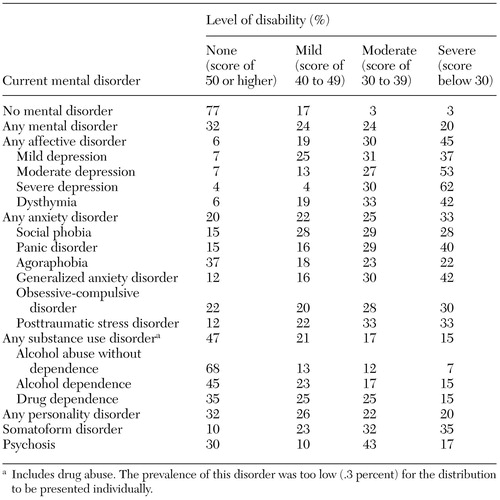 |
Table 1. Severity of disability as measured by the mental health summary scale of the Medical Outcomes Study 12-item Short Form among persons in a community sample with current diagnoses of mental disorders
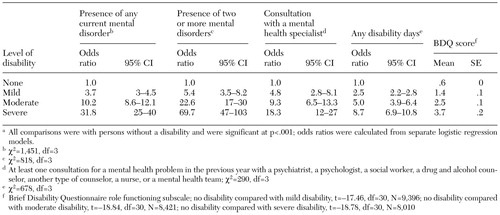 |
Table 2. Relationship between levels of disability, as measured by the mental health summary scale of the Medical Outcomes Study 12-item Short Form, and other indicators of disability in a community samplea
a All comparisons were with persons without a disability and were significant at p<001; odds ratios were calculated from separate logistic regression models.
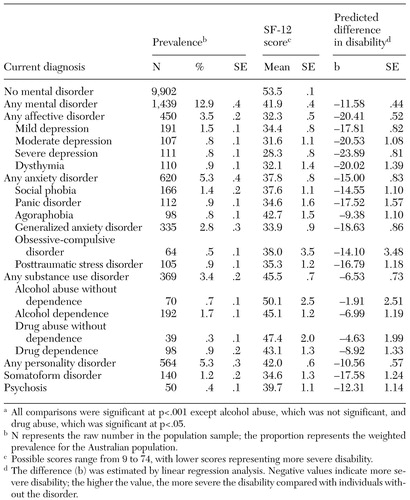 |
Table 3. Mean scores of a community sample on the mental health summary scale of the Medical Outcomes Study 12-item Short Form (SF-12), by diagnosis, and predicted difference in disability between people with and without that diagnosisa
a All comparisons were significant at p<001 except alcohol abuse, which was not significant, and drug abuse, which was significant at p<.05.
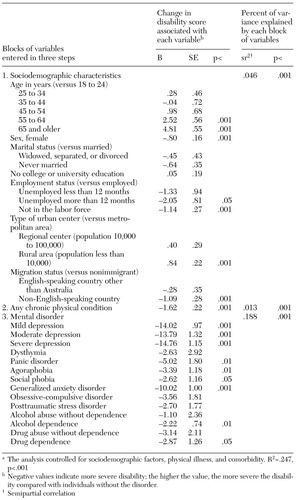 |
Table 4. Results of hierarchical linear regression to determine the significance of psychiatric diagnosis in predicting scores on the mental health summary scale of the Medical Outcomes Study 12-item Short Forma
a The analysis controlled for sociodemographic factors, physical illness, and comorbidityR2 =.247, p<.001
1. Smith GR Jr, Manderscheid RW, Flynn LM, et al: Principles for assessment of patient outcomes in mental health care. Psychiatric Services 48:1033-1036, 1997Link, Google Scholar
2. Goldman HH, Skodol AE, Lave TR: Revising axis V for DSM-IV: a review of measures of social functioning. American Journal of Psychiatry 149:1148-1156, 1992Link, Google Scholar
3. Eisen SV, Dill DD, Grob MC: Reliability and validity of a brief patient report instrument for psychiatric outcome evaluation. Hospital and Community Psychiatry 45:242-247, 1994Abstract, Google Scholar
4. Lehman AF: Measures of quality of life among persons with severe and persistent mental disorders. Social Psychiatry and Psychiatric Epidemiology 31:78-88, 1996Crossref, Medline, Google Scholar
5. Wing JK, Beevor AS, Curtis RH, et al: Health of the Nation Outcome Scales (HoNOS): research and development. British Journal of Psychiatry 172:11-18, 1998Crossref, Medline, Google Scholar
6. Rosenheck RA: Principles for priority setting in mental health services and their implications for the least well off. Psychiatric Services 50:653-658, 1999Link, Google Scholar
7. Adler DA, Bungay KM, Cynn DJ, et al: Patient-based health status assessments in an outpatient psychiatry setting. Psychiatric Services 51:341-348, 2000Link, Google Scholar
8. Kessler RC, Frank RG: The impact of psychiatric disorders on work loss days. Psychological Medicine 27:861-873, 1997Crossref, Medline, Google Scholar
9. Kouzis AC, Eaton WW: Emotional disability days: prevalence and predictors. American Journal of Public Health 84:1304-1307, 1994Crossref, Medline, Google Scholar
10. Ormel J, Von Korff M, Ustun TB, et al: Common mental disorders and disability across cultures: results from the WHO collaborative study on psychological problems in general health care. JAMA 272:1741-1748, 1994Crossref, Medline, Google Scholar
11. Sherbourne CD, Wells KB, Judd LL: Functioning and well-being of patients with panic disorder. American Journal of Psychiatry 153:213-218, 1996Link, Google Scholar
12. Murray CJL, Lopez AD: Global mortality, disability, and the contribution of risk factors: global burden of disease study. Lancet 349:1436-1442, 1997Crossref, Medline, Google Scholar
13. Spitzer RL, Kroenke J, Linzer M, et al: Health-related quality of life in primary care patients with mental disorders. JAMA 274:1511-1517, 1995Crossref, Medline, Google Scholar
14. Olfson M, Fireman B, Weissman MM, et al: Mental disorders and disability among patients in a primary care group practice. American Journal of Psychiatry 154:1734-1740, 1997Link, Google Scholar
15. Hollifield M, Katon W, Skipper B, et al: Panic disorder and quality of life: variables predictive of functional impairment. American Journal of Psychiatry 154:766-772, 1997Link, Google Scholar
16. Bassett SS, Chase GA, Folstein MF, et al: Disability and psychiatric disorders in an urban community: measurement, prevalence, and outcomes. Psychological Medicine 28:509-517, 1998Crossref, Medline, Google Scholar
17. Bijl RV, Ravelli A: Current and residual functional disability associated with psychopathology: findings from the Netherlands Mental Health Survey and Incidence Study (NEMESIS). Psychological Medicine 30:657-668, 2000Crossref, Medline, Google Scholar
18. Andrews G, Sanderson K, Beard J: Burden of disease: methods for calculating disability from mental disorder. British Journal of Psychiatry 173:123-131, 1998Crossref, Medline, Google Scholar
19. Ware JE, Kosinski M, Keller SD: A 12-item short-form health survey: construction of scales and preliminary tests of reliability and validity. Medical Care 34:220-233, 1996Crossref, Medline, Google Scholar
20. Andrews G, Henderson S, Hall W: Prevalence, comorbidity, disability, and service utilisation: overview of the Australian National Mental Health Survey. British Journal of Psychiatry 178:145-153, 2001Crossref, Medline, Google Scholar
21. Andrews G, Peters L: Psychometric properties of the CIDI. Social Psychiatry and Psychiatric Epidemiology 33:80-88, 1998Crossref, Medline, Google Scholar
22. Loranger AW, Janca A, Sartorius N: Assessment and Diagnosis of Personality Disorders: The ICD-10 International Personality Disorder Examination (IPDE). Cambridge, England, Cambridge University Press, 1997Google Scholar
23. Jablensky A, McGrath J, Hermann H, et al: Psychotic disorders in urban areas. Australian and New Zealand Journal of Psychiatry 34:221-236, 2000Crossref, Medline, Google Scholar
24. Tacchini R, Janca A, Isaacs M: Neurasthenia. Geneva, World Health Organization, Division of Mental Health, 1995 (as amended by Hickie I, department of psychiatry, St George Hospital, Sydney, Australia)Google Scholar
25. Hickie I, Hadzi-Pavlovic D, Ricci C: Reviving the diagnosis of neurasthenia. Psychological Medicine 27:989-994, 1997Crossref, Medline, Google Scholar
26. Belloc NB, Breslow L, Hochstim JR: Measurement of physical health in a general population survey. American Journal of Epidemiology 93:328-336, 1971Crossref, Medline, Google Scholar
27. Ormel J, Von Korff M, Oldehinkel AJ, et al: Onset of disability in depressed and non-depressed primary care patients. Psychological Medicine 29:847-853, 1999Crossref, Medline, Google Scholar
28. Shah BV, Barnwell BG, Biegler GS: SUDAAN User's Manual. Research Triangle Park, NC, Research Triangle Institute, 1997Google Scholar
29. Ware JE, Kosinski M, Keller SD: SF-36 Physical and Mental Health Summary Scales: A User's Manual. Boston, Health Institute, 1994Google Scholar
30. Kessler RC, DuPont RL, Berglund P, et al: Impairment in pure and comorbid generalized anxiety disorder and major depression at 12 months in two national surveys. American Journal of Psychiatry 156:1915-1923, 1999Link, Google Scholar
31. Wells KB, Sherbourne CD: Functioning and utility for current health of patients with depression or chronic medical conditions in managed, primary care practices. Archives of General Psychiatry 56:897-904, 1999Crossref, Medline, Google Scholar
32. Leon AC, Shear MK, Portera L, et al: Assessing impairment in patients with panic disorder: the Sheehan Disability Scale. Social Psychiatry and Psychiatric Epidemiology 27:78-82, 1992Crossref, Medline, Google Scholar
33. Volk RJ, Cantor SB, Steinbauer JR, et al: Alcohol use disorders, consumption patterns, and health-related quality of life of primary care patients. Alcohol: Clinical and Experimental Research 21:899-905, 1997Crossref, Medline, Google Scholar
34. Atkinson M, Zibin S, Chuang H: Characterizing quality of life among patients with chronic mental illness: a critical examination of the self-report methodology. American Journal of Psychiatry 154:99-105, 1997Link, Google Scholar
35. Hawthorne WB, Green EE, Lohr JB, et al: Comparison of outcomes of acute care in short-term residential treatment and psychiatric hospital settings. Psychiatric Services 50:401-406, 1999Link, Google Scholar
36. Khatri N, Romney DM, Pelletier G: Validity of self-reports about quality of life among patients with schizophrenia. Psychiatric Services 52:534-535, 2001Link, Google Scholar
37. Leon AC, Solomon DA, Mueller TI, et al: The Range of Impaired Functioning Tool (LIFE-RIFT): a brief measure of functional impairment. Psychological Medicine 29:869-878, 1999Crossref, Medline, Google Scholar
38. Zhang M, Rost K, Fortney J, et al: A community study of depression treatment and employment. Psychiatric Services 50:1209-1213, 1999Link, Google Scholar
39. Hofmann SG, Barlow DH: The costs of anxiety disorders: implications for psychosocial interventions, in Cost-Effectiveness of Psychotherapy. Edited by Miller NE, Magruder KM. New York, Oxford University Press, 1999Google Scholar


